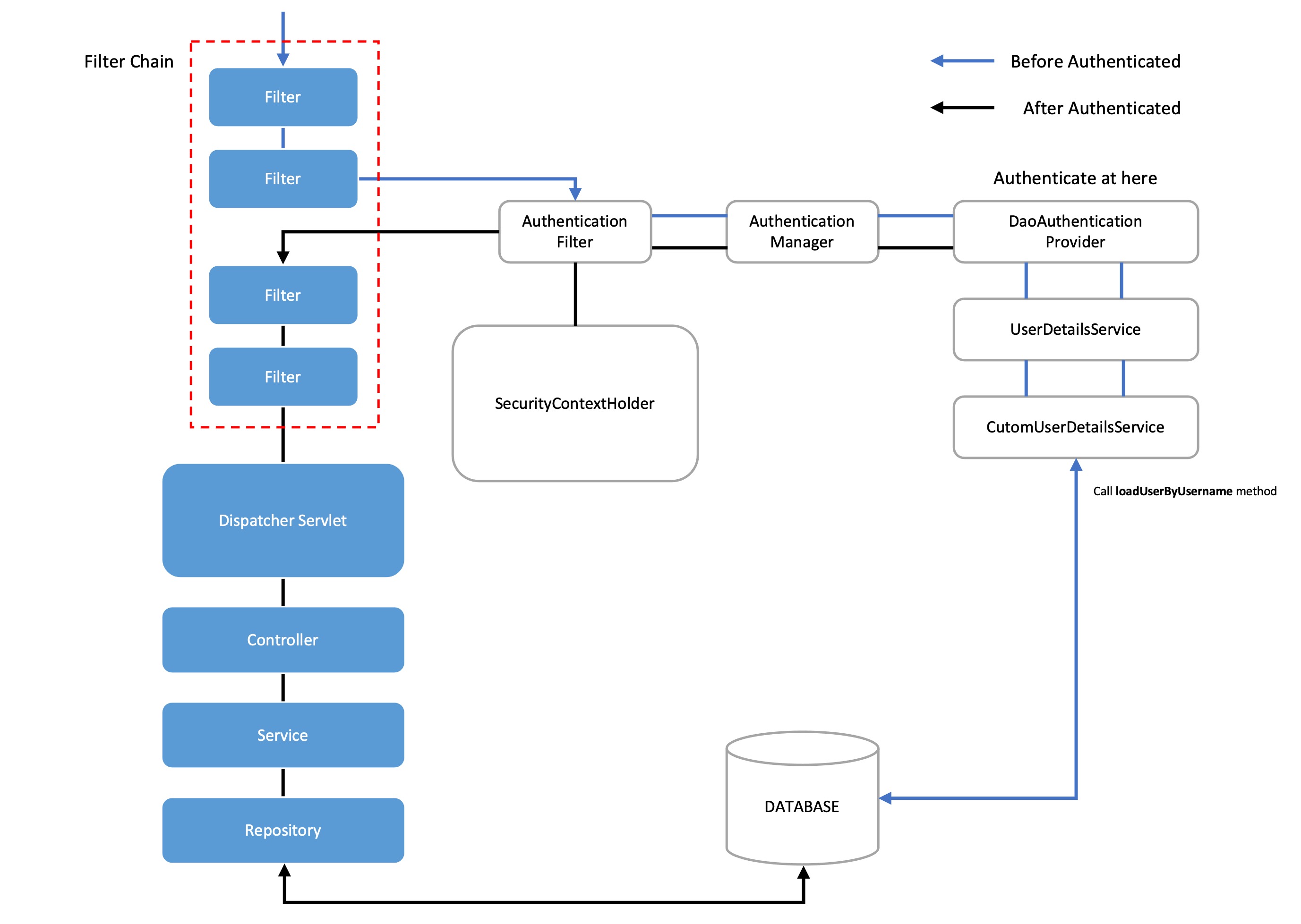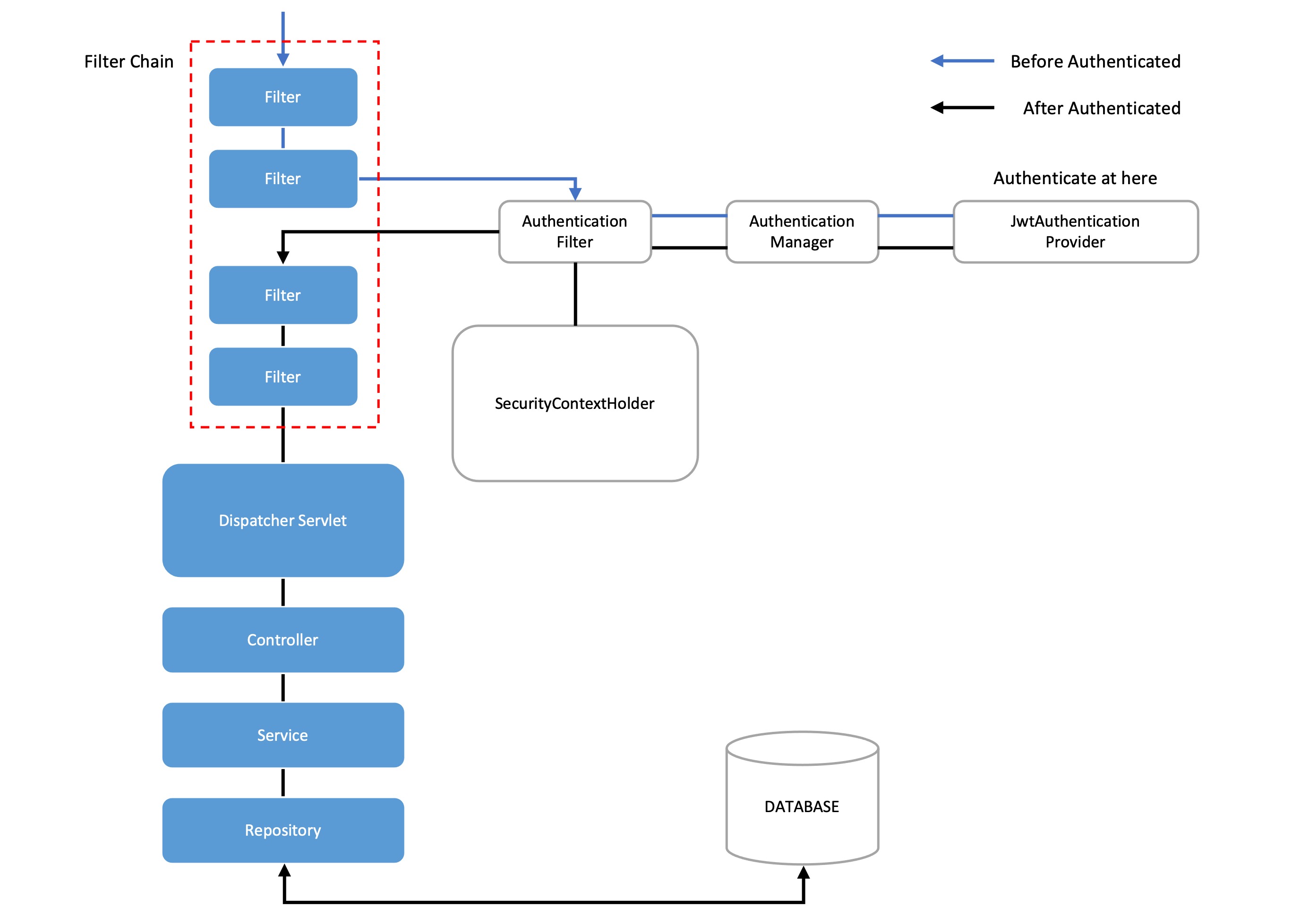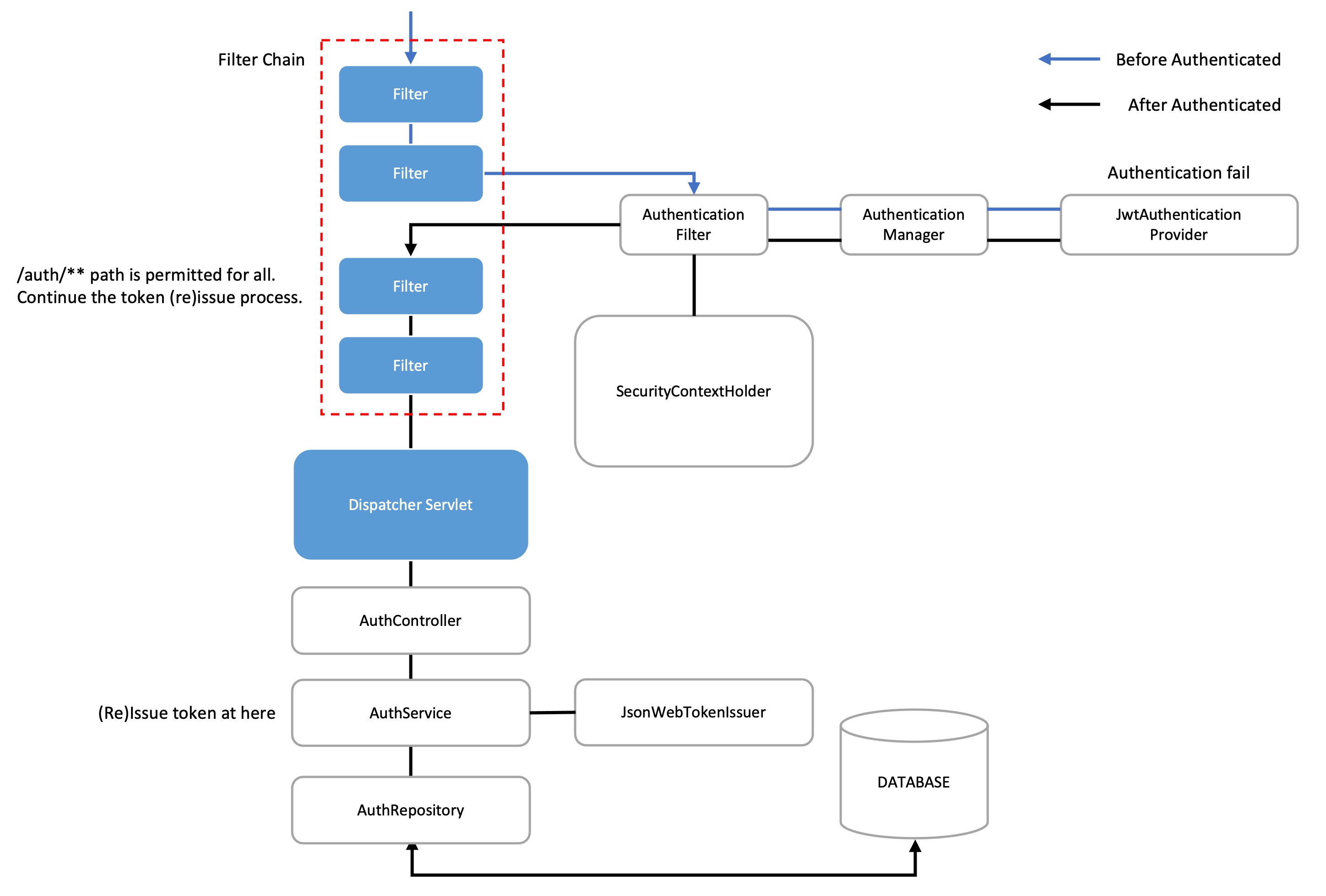JWT(Json Web Token) 발행과 재발행
RECOMMEND POSTS BEFORE THIS
1. Spring Security Authentication Process with JWT
이번 글은 토큰 발행과 재발행과 관련된 로직을 다룬다. 구현 코드를 설명하기에 앞서 스프링 시큐리티(spring security) 프레임워크의 기본적인 인증 프로세스와 의도하고 있는 인증 프로세스를 다시 정리해보자
- AuthenticationFilter 인스턴스는 AuthenticationManager 인스턴스에게 인증 절차를 위임한다.
- AuthenticationManager 인스턴스는 AuthenticationProvider 인스턴스에게 인증 절차를 위임한다.
- 기본적으로 사용되는 인증 제공자는 DaoAuthenticationProvider 객체다.
- DaoAuthenticationProvider 객체는 데이터베이스에서 사용자 정보를 조회하기 위해 UserDetailsService 인스턴스를 사용한다.
- 이 단계에서 프레임워크를 이용하는 개발자가 구현한 객체가 사용된다.
- UserDetailsService 인터페이스를 구현한 CustomUserDetailsService 클래스가 사용된다.
- 영속성 관련 기술 스택에 따라 적절하게 데이터베이스에서 사용자 정보를 조회한다.

위 인증 프로세스에 JWT(json web token)을 사용한 인증 프로세스를 얹었다. 관련된 내용은 이전 글에서 다뤘으니 짧게 살펴보자.
- AuthenticationFilter 인스턴스에서 HTTP 요청 헤더로부터 JWT을 추출한다.
- AuthenticationFilter 인스턴스는 AuthenticationManager 인스턴스에게 인증 절차를 위임하며, JWT을 전달한다.
- AuthenticationManager 인스턴스는 AuthenticationProvider 인스턴스에게 인증 절차를 위임하며, JWT을 전달한다.
- 인증 매니저 객체는 이전 글에서 구현한 JwtAuthenticationProvider 객체를 사용한다. 토큰의 유효성만 확인하기 때문에 UserDetailsService 인스턴스를 사용할 필요가 없다.

이제 위 프로세스에서 JWT를 발급, 재발급 하는 기능을 추가한다. AuthController 객체를 통해 엔드포인트를 만들고 아래와 같이 구현을 확장해간다.SecurityConfig 객체를 통한 인가 설정에서 /auth/** 경로에 대해 모두 인증 없이도 접근할 수 있도록 허가했다. 토큰 발행과 재발행 시 API 경로는 /auth/**에 포함되므로 인증된 사용자가 아니더라도 발급 프로세스는 계속 진행된다. 주요 비즈니스 로직은 AuthService 객체가 책임진다.
- 토큰 발행
- ID와 비밀번호를 통해 정상적인 사용자임을 확인한다.
- 정상적인 사용자인 경우 액세스 토큰(access token)과 리프레시 토큰(refresh token)을 발급한다.
- 토큰 재발행
- 전달받은 리프레시 토큰의 유효성을 검사한다.
- 유효한 리프레시 토큰인 경우 추출한 클레임(claim) 정보에서 사용자 ID를 추출한다.
- 추출한 사용자 ID를 이용해 사용자 정보를 조회하고 새로운 액세스 토큰과 리프레시 토큰을 발급한다.

2. Package structure and change configuration
이전 글에 이어서 구현 코드를 작성한다. 패키지 구조는 다음과 같다.
.
├── HELP.md
├── action-in-blog.iml
├── mvnw
├── mvnw.cmd
├── pom.xml
└── src
├── main
│ ├── java
│ │ └── action
│ │ └── in
│ │ └── blog
│ │ ├── ActionInBlogApplication.java
│ │ ├── filters
│ │ │ └── JwtAuthenticationFilter.java
│ │ └── security
│ │ ├── config
│ │ │ ├── JwtSecurityConfig.java
│ │ │ └── SecurityConfig.java
│ │ ├── controller
│ │ │ └── AuthController.java
│ │ ├── dto
│ │ │ ├── JsonWebTokenDto.java
│ │ │ └── UserDto.java
│ │ ├── entity
│ │ │ └── User.java
│ │ ├── exception
│ │ │ └── JwtInvalidException.java
│ │ ├── provider
│ │ │ └── JwtAuthenticationProvider.java
│ │ ├── repository
│ │ │ └── AuthRepository.java
│ │ ├── service
│ │ │ └── AuthService.java
│ │ ├── tokens
│ │ │ └── JwtAuthenticationToken.java
│ │ └── utils
│ │ └── JsonWebTokenIssuer.java
│ └── resources
│ ├── application-test.yml
│ ├── application.yml
│ ├── db
│ │ ├── data.sql
│ │ └── schema.sql
│ ├── static
│ └── templates
└── test
└── java
└── action
└── in
└── blog
├── ActionInBlogApplicationTests.java
├── filters
│ └── JwtAuthenticationFilterTest.java
└── security
├── controller
│ └── AuthControllerTest.java
├── provider
│ └── JwtAuthenticationProviderTest.java
├── repository
│ └── AuthRepositoryTest.java
├── service
│ └── AuthServiceTest.java
└── utils
└── JsonWebTokenIssuerTest.java
테스트를 위한 설정이 포함되었으므로 spring.profiles 속성을 통해 설정을 구분한다.
spring:
profiles:
active: test
application-test YAML 파일에 테스트를 위한 설정을 추가한다.
spring.sql.init속성을 통해 서비스가 시작하는 시점에 미리 테이블 스키마와 데이터를 추가한다.schema-locations- 데이터베이스 스키마 SQL 설정data-locations- 데이터베이스 초기 데이터 INSERT SQL 설정
jwt.refresh-secret속성을 통해 리프레시 토큰(refresh token)을 만들 때 사용할 키를 추가하였다.- JPA와 H2 설정을 추가한다.
spring:
sql:
init:
mode: always
schema-locations: classpath:db/schema.sql
data-locations: classpath:db/data.sql
jpa:
show-sql: true
hibernate:
ddl-auto: none
defer-datasource-initialization: true
datasource:
driver-class-name: org.h2.Driver
url: jdbc:h2:~/test
username: sa
password:
h2:
console:
path: /h2-console
enabled: true
jwt:
secret: validSecretKey
refresh-secret: refreshSecretKey
마이그레이션(migration)을 위한 사용자 테이블을 만드는 SQL 스크립트를 작성한다.
drop table if exists tb_user CASCADE;
create table tb_user
(
user_name varchar(255) not null,
password varchar(255),
authority varchar(255),
primary key (user_name)
);
사용자 정보를 준비하기 위한 SQL 스크립트도 추가한다.
- 비밀번호는 문자열 “123”을 미리 인코딩한 값이다.
insert into tb_user (user_name, password, authority)
values ('Junhyunny', '{bcrypt}$2a$10$LDwzHdFsoeeo0CjXoYdmwelLK4CjdiMtGvPHDYPQ039JEx19L7C8e', 'ROLE_ADMIN');
3. Implementation codes
다음과 같은 클래스들이 추가되었다.
- JsonWebTokenDto 클래스
- 액세스 토큰, 리프레시 토큰, 인증 타입을 가진 클래스
- UserDto 클래스
- 사용자 이름, 비밀번호를 전달받는 클래스
- User 클래스
- JPA 엔티티 클래스
- JsonWebTokenIssuer 클래스
- 토큰 발행, 리프레시 토큰 파싱 기능 제공
- AuthService 클래스
- 로그인 처리, 토큰 재발행 기능 제공
- AuthRepository 클래스
- 사용자 조회 기능 제공
단순하게 필드만 있는 DTO(Data Transfer Object)와 엔티티(Entity) 클래스에 대한 내용은 다루지 않았다. AuthRepository 인터페이스도 JpaRepository 인터페이스를 상속하였을 뿐 추가한 기능이 없으므로 설명하지 않았다.
3.1. JsonWebTokenIssuer class
JsonWebTokenIssuer 클래스는 토큰 발행과 리프래시 토큰에서 클레임 정보를 추출하는 기능을 제공한다. 액세스 토큰과 리프레시 토큰을 만들 때 사용하는 비밀 키는 다른 값을 사용한다. 액세스 토큰과 리프레시 토큰 만료 시간은 설정을 통해 주입 받을 수 있지만 기본 값을 지정해주었다. 액세스 토큰 만료 시간은 10분, 리프레시 토큰 만료 시간 30분이다.
createAccessToken메소드- 액세스 토큰을 발급한다.
createRefreshToken메소드- 리프레시 토큰을 발급한다.
parseClaimsFromRefreshToken메소드- 리프레시 토큰에서 클레임 정보를 추출한다.
package action.in.blog.security.utils;
import action.in.blog.security.exception.JwtInvalidException;
import io.jsonwebtoken.*;
import org.springframework.beans.factory.annotation.Value;
import org.springframework.stereotype.Component;
import java.util.Collections;
import java.util.Date;
@Component
public class JsonWebTokenIssuer {
private final int ONE_SECONDS = 1000;
private final int ONE_MINUTE = 60 * ONE_SECONDS;
private final String KEY_ROLES = "roles";
private final byte[] secretKeyBytes;
private final byte[] refreshSecretKeyBytes;
private final int expireMin;
private final int refreshExpireMin;
public JsonWebTokenIssuer(
@Value("${jwt.secret}") String secretKey,
@Value("${jwt.refresh-secret}") String refreshSecretKey,
@Value("${jwt.expire-min:10}") int expireMin,
@Value("${jwt.refresh-expire-min:30}") int refreshExpireMin) {
this.secretKeyBytes = secretKey.getBytes();
this.refreshSecretKeyBytes = refreshSecretKey.getBytes();
this.expireMin = expireMin;
this.refreshExpireMin = refreshExpireMin;
}
private String createToken(String userName, String authority, byte[] secretKeyBytes, int expireMin) {
Date now = new Date();
Claims claims = Jwts.claims().setSubject(userName);
claims.put(KEY_ROLES, Collections.singleton(authority));
return Jwts.builder()
.setClaims(claims)
.setIssuedAt(now)
.setExpiration(new Date(now.getTime() + ONE_MINUTE * expireMin))
.signWith(SignatureAlgorithm.HS256, secretKeyBytes)
.compact();
}
public String createAccessToken(String userName, String authority) {
return createToken(userName, authority, secretKeyBytes, expireMin);
}
public String createRefreshToken(String userName, String authority) {
return createToken(userName, authority, refreshSecretKeyBytes, refreshExpireMin);
}
public Claims parseClaimsFromRefreshToken(String jsonWebToken) {
Claims claims;
try {
claims = Jwts.parser().setSigningKey(refreshSecretKeyBytes).parseClaimsJws(jsonWebToken).getBody();
} catch (SignatureException signatureException) {
throw new JwtInvalidException("signature key is different", signatureException);
} catch (ExpiredJwtException expiredJwtException) {
throw new JwtInvalidException("expired token", expiredJwtException);
} catch (MalformedJwtException malformedJwtException) {
throw new JwtInvalidException("malformed token", malformedJwtException);
} catch (IllegalArgumentException illegalArgumentException) {
throw new JwtInvalidException("using illegal argument like null", illegalArgumentException);
}
return claims;
}
}
3.2. AuthService class
AuthService 객체는 로그인, 토큰 발급, 재발급과 관련된 책임을 맡는다. AuthService 객체는 다양한 예외(exception)들을 던지지만, 모두 AuthenticationException 예외을 상속 받았다. AuthenticationException 예외를 던지면, 필터 체인에서 403(forbidden) 처리를 수행한다. 이는 테스트 코드에서 확인 가능하다.
- login 메소드
- 아이디를 이용해 존재하는 사용자인지 조회하고, 없는 경우 UsernameNotFoundException 예외을 던진다.
- 인코딩 된 비밀번호와 전달받은 비밀번호를 비교하고, 다른 경우 BadCredentialsException 예외을 던진다.
- 사용자 인증에 성공하면 JsonWebTokenDto 객체를 만들어 전달한다.
- reissue 메소드
- 파라미터로 전달 받은 토큰이 Bearer 인증 타입이 아닌 경우 JwtInvalidException 예외을 던진다.
- jwtIssuer 객체를 통해 리프레시 토큰으로부터 클레임 정보를 추출하며, 없는 경우 JwtInvalidException 예외을 던진다.
- 아이디를 이용해 존재하는 사용자인지 조회하고, 없는 경우 UsernameNotFoundException 예외을 던진다.
- 위 단계를 모두 통과하면 JsonWebTokenDto 객체를 만들어 전달한다.
package action.in.blog.security.service;
import action.in.blog.security.dto.JsonWebTokenDto;
import action.in.blog.security.dto.UserDto;
import action.in.blog.security.entity.User;
import action.in.blog.security.exception.JwtInvalidException;
import action.in.blog.security.repository.AuthRepository;
import action.in.blog.security.utils.JsonWebTokenIssuer;
import io.jsonwebtoken.Claims;
import org.springframework.security.authentication.BadCredentialsException;
import org.springframework.security.core.userdetails.UsernameNotFoundException;
import org.springframework.security.crypto.password.PasswordEncoder;
import org.springframework.stereotype.Service;
import org.springframework.util.StringUtils;
@Service
public class AuthService {
private final String GRANT_TYPE_BEARER = "Bearer";
private final AuthRepository authRepository;
private final PasswordEncoder passwordEncoder;
private final JsonWebTokenIssuer jwtIssuer;
public AuthService(
AuthRepository authRepository,
PasswordEncoder passwordEncoder,
JsonWebTokenIssuer jwtIssuer) {
this.authRepository = authRepository;
this.passwordEncoder = passwordEncoder;
this.jwtIssuer = jwtIssuer;
}
private String resolveToken(String bearerToken) {
if (StringUtils.hasText(bearerToken) && bearerToken.startsWith(GRANT_TYPE_BEARER)) {
return bearerToken.substring(7);
}
return null;
}
private JsonWebTokenDto createJsonWebTokenDto(User user) {
String userName = user.getUserName();
String authority = user.getAuthority();
return JsonWebTokenDto.builder()
.grantType(GRANT_TYPE_BEARER)
.accessToken(jwtIssuer.createAccessToken(userName, authority))
.refreshToken(jwtIssuer.createRefreshToken(userName, authority))
.build();
}
public JsonWebTokenDto login(UserDto userDto) {
User user = authRepository.findById(userDto.getUserName())
.orElseThrow(() -> new UsernameNotFoundException("username is not found"));
if (!passwordEncoder.matches(userDto.getPassword(), user.getPassword())) {
throw new BadCredentialsException("bad credential: using unmatched password");
}
return createJsonWebTokenDto(user);
}
public JsonWebTokenDto reissue(String bearerToken) {
String refreshToken = resolveToken(bearerToken);
if (!StringUtils.hasText(refreshToken)) {
throw new JwtInvalidException("invalid grant type");
}
Claims claims = jwtIssuer.parseClaimsFromRefreshToken(refreshToken);
if (claims == null) {
throw new JwtInvalidException("not exists claims in token");
}
User user = authRepository.findById(claims.getSubject())
.orElseThrow(() -> new UsernameNotFoundException("username is not found"));
return createJsonWebTokenDto(user);
}
}
3.3. AuthController class
AuthController 클래스에는 인증에 관련된 기능을 외부로 노출하는 엔드포인트가 정의되어 있다.
- login 메소드
- 사용자 로그인 정보를 UserDto 객체를 통해 전달받는다.
- reissue 메소드
- 요청 헤더 정보에서 토큰 정보를 꺼낸다.
- 헤더에 토큰이 없는 경우 요청은 400(bad request) 처리된다.
package action.in.blog.security.controller;
import action.in.blog.security.dto.JsonWebTokenDto;
import action.in.blog.security.dto.UserDto;
import action.in.blog.security.service.AuthService;
import lombok.extern.log4j.Log4j2;
import org.springframework.web.bind.annotation.PostMapping;
import org.springframework.web.bind.annotation.RequestHeader;
import org.springframework.web.bind.annotation.RequestMapping;
import org.springframework.web.bind.annotation.RestController;
@Log4j2
@RestController
@RequestMapping("/auth")
public class AuthController {
private final String AUTHORIZATION_HEADER = "Authorization";
private final AuthService authService;
public AuthController(AuthService authService) {
this.authService = authService;
}
@PostMapping("/login")
public JsonWebTokenDto login(UserDto userDto) {
return authService.login(userDto);
}
@PostMapping("/reissue")
public JsonWebTokenDto reissue(@RequestHeader(AUTHORIZATION_HEADER) String bearerToken) {
return authService.reissue(bearerToken);
}
}
4. Test codes
주요 기능들에 대한 테스트를 살펴보자. 먼저 JsonWebTokenIssuer 객체에 대한 테스트는 다음과 같다.
package action.in.blog.security.utils;
import action.in.blog.security.exception.JwtInvalidException;
import io.jsonwebtoken.Claims;
import io.jsonwebtoken.JwtParser;
import io.jsonwebtoken.Jwts;
import org.junit.jupiter.api.BeforeEach;
import org.junit.jupiter.api.Test;
import org.mockito.MockedStatic;
import org.mockito.Mockito;
import java.util.List;
import static org.hamcrest.MatcherAssert.assertThat;
import static org.hamcrest.Matchers.equalTo;
import static org.hamcrest.Matchers.isA;
import static org.junit.jupiter.api.Assertions.assertThrows;
public class JsonWebTokenIssuerTest {
JsonWebTokenIssuer jsonWebTokenIssuer;
@BeforeEach
public void setup() {
jsonWebTokenIssuer = new JsonWebTokenIssuer(
"secretKey",
"refreshSecretKey",
10,
30);
}
Claims parseClaims(String jsonWebToken, String secretKey) {
return Jwts.parser()
.setSigningKey(secretKey.getBytes())
.parseClaimsJws(jsonWebToken)
.getBody();
}
@Test
public void givenUser_whenCreateAccessTokenByUser_thenParsedClaimsWithSameValue() {
String jwt = jsonWebTokenIssuer.createAccessToken("Junhyunny", "ROLE_ADMIN");
Claims claims = parseClaims(jwt, "secretKey");
assertThat(claims.getSubject(), equalTo("Junhyunny"));
assertThat(claims.get("roles"), isA(List.class));
List<String> roles = (List) claims.get("roles");
for (String role : roles) {
assertThat(role, equalTo("ROLE_ADMIN"));
}
}
@Test
public void givenUser_whenCreateRefreshTokenByUser_thenParsedClaimsWithSameValue() {
String jwt = jsonWebTokenIssuer.createRefreshToken("Junhyunny", "ROLE_ADMIN");
Claims claims = parseClaims(jwt, "refreshSecretKey");
assertThat(claims.getSubject(), equalTo("Junhyunny"));
assertThat(claims.get("roles"), isA(List.class));
List<String> roles = (List) claims.get("roles");
for (String role : roles) {
assertThat(role, equalTo("ROLE_ADMIN"));
}
}
@Test
public void givenInValidRefreshToken_whenParseClaimsFromRefreshToken_thenThrowJwtInvalidException() {
String invalidRefreshToken = "invalid refresh token";
assertThrows(JwtInvalidException.class, () -> {
jsonWebTokenIssuer.parseClaimsFromRefreshToken(invalidRefreshToken);
});
}
@Test
public void givenAccessToken_whenParseClaimsFromRefreshToken_thenThrowsJwtInvalidException() {
String accessToken = jsonWebTokenIssuer.createAccessToken("Junhyunny", "ROLE_ADMIN");
assertThrows(JwtInvalidException.class, () -> {
jsonWebTokenIssuer.parseClaimsFromRefreshToken(accessToken);
});
}
@Test
public void givenRefreshToken_whenParseClaimsFromRefreshToken_thenReturnClaims() {
String refreshToken = jsonWebTokenIssuer.createRefreshToken("Junhyunny", "ROLE_ADMIN");
Claims claims = jsonWebTokenIssuer.parseClaimsFromRefreshToken(refreshToken);
assertThat(claims.getSubject(), equalTo("Junhyunny"));
assertThat(claims.get("roles"), isA(List.class));
List<String> roles = (List) claims.get("roles");
for (String role : roles) {
assertThat(role, equalTo("ROLE_ADMIN"));
}
}
}
다음은 AuthService 객체에 대한 테스트다.
package action.in.blog.security.service;
import action.in.blog.security.dto.JsonWebTokenDto;
import action.in.blog.security.dto.UserDto;
import action.in.blog.security.entity.User;
import action.in.blog.security.exception.JwtInvalidException;
import action.in.blog.security.repository.AuthRepository;
import action.in.blog.security.utils.JsonWebTokenIssuer;
import io.jsonwebtoken.Claims;
import io.jsonwebtoken.Jwts;
import org.junit.jupiter.api.BeforeEach;
import org.junit.jupiter.api.Test;
import org.mockito.Mockito;
import org.springframework.security.authentication.BadCredentialsException;
import org.springframework.security.core.userdetails.UsernameNotFoundException;
import org.springframework.security.crypto.factory.PasswordEncoderFactories;
import org.springframework.security.crypto.password.PasswordEncoder;
import java.util.Collections;
import java.util.Optional;
import static org.hamcrest.MatcherAssert.assertThat;
import static org.hamcrest.Matchers.equalTo;
import static org.hamcrest.Matchers.isA;
import static org.junit.jupiter.api.Assertions.assertThrows;
import static org.mockito.Mockito.when;
public class AuthServiceTest {
AuthRepository mockAuthRepository;
PasswordEncoder passwordEncoder;
JsonWebTokenIssuer mockJwtIssuer;
AuthService authService;
@BeforeEach
public void setup() {
mockAuthRepository = Mockito.mock(AuthRepository.class);
passwordEncoder = PasswordEncoderFactories.createDelegatingPasswordEncoder();
mockJwtIssuer = Mockito.mock(JsonWebTokenIssuer.class);
authService = new AuthService(mockAuthRepository, passwordEncoder, mockJwtIssuer);
}
UserDto getUserDto(String userName, String password) {
return UserDto.builder()
.userName(userName)
.password(password)
.build();
}
User getUser(String userName, String password, String authority) {
return User.builder()
.userName(userName)
.password(passwordEncoder.encode(password))
.authority(authority)
.build();
}
@Test
public void givenNotExistUserName_whenLogin_thenThrowUsernameNotFoundException() {
UserDto userDto = getUserDto("Junhyunny", "1234");
Throwable throwable = assertThrows(UsernameNotFoundException.class, () -> {
authService.login(userDto);
});
assertThat(throwable, isA(UsernameNotFoundException.class));
assertThat(throwable.getMessage(), equalTo("username is not found"));
}
@Test
public void givenNotMatchedPassword_whenLogin_thenThrowBadCredentialsException() {
UserDto userDto = getUserDto("Junhyunny", "1234");
when(mockAuthRepository.findById("Junhyunny")).thenReturn(
Optional.of(
getUser("Junhyunny", "12345", "ROLE_ADMIN")
)
);
Throwable throwable = assertThrows(BadCredentialsException.class, () -> {
authService.login(userDto);
});
assertThat(throwable, isA(BadCredentialsException.class));
assertThat(throwable.getMessage(), equalTo("bad credential: using unmatched password"));
}
@Test
public void givenValidUserDto_whenLogin_thenReturnJsonWebTokenDto() {
UserDto userDto = getUserDto("Junhyunny", "1234");
User user = getUser("Junhyunny", "1234", "ROLE_ADMIN");
when(mockAuthRepository.findById("Junhyunny")).thenReturn(Optional.of(user));
when(mockJwtIssuer.createAccessToken("Junhyunny", "ROLE_ADMIN")).thenReturn("accessToken");
when(mockJwtIssuer.createRefreshToken("Junhyunny", "ROLE_ADMIN")).thenReturn("refreshToken");
JsonWebTokenDto jsonWebTokenDto = authService.login(userDto);
assertThat(jsonWebTokenDto.getGrantType(), equalTo("Bearer"));
assertThat(jsonWebTokenDto.getAccessToken(), equalTo("accessToken"));
assertThat(jsonWebTokenDto.getRefreshToken(), equalTo("refreshToken"));
}
@Test
public void givenInvalidGrandType_whenReissue_thenThrowJwtInvalidException() {
Throwable throwable = assertThrows(JwtInvalidException.class, () -> {
authService.reissue("refreshToken");
});
assertThat(throwable.getMessage(), equalTo("invalid grant type"));
}
@Test
public void givenNullClaims_whenReissue_thenThrowJwtInvalidException() {
when(mockJwtIssuer.parseClaimsFromRefreshToken("refreshToken")).thenReturn(null);
Throwable throwable = assertThrows(JwtInvalidException.class, () -> {
authService.reissue("Bearer refreshToken");
});
assertThat(throwable.getMessage(), equalTo("not exists claims in token"));
}
@Test
public void givenValidRefreshToken_whenReissue_thenJsonWebTokenDto() {
User user = getUser("Junhyunny", "1234", "ROLE_ADMIN");
Claims claims = Jwts.claims().setSubject("Junhyunny");
claims.put("roles", Collections.singleton("ROLE_ADMIN"));
when(mockAuthRepository.findById("Junhyunny")).thenReturn(Optional.of(user));
when(mockJwtIssuer.parseClaimsFromRefreshToken("refreshToken")).thenReturn(claims);
when(mockJwtIssuer.createAccessToken("Junhyunny", "ROLE_ADMIN")).thenReturn("accessToken");
when(mockJwtIssuer.createRefreshToken("Junhyunny", "ROLE_ADMIN")).thenReturn("refreshToken");
JsonWebTokenDto jsonWebTokenDto = authService.reissue("Bearer refreshToken");
assertThat(jsonWebTokenDto.getGrantType(), equalTo("Bearer"));
assertThat(jsonWebTokenDto.getAccessToken(), equalTo("accessToken"));
assertThat(jsonWebTokenDto.getRefreshToken(), equalTo("refreshToken"));
}
}
다음은 AuthController 객체에 대한 테스트 코드다. 추가된 테스트 메소드들만 확인해본다.
package action.in.blog.security.controller;
import action.in.blog.security.dto.JsonWebTokenDto;
import action.in.blog.security.utils.JsonWebTokenIssuer;
import com.fasterxml.jackson.databind.ObjectMapper;
import io.jsonwebtoken.Claims;
import io.jsonwebtoken.Jwts;
import io.jsonwebtoken.SignatureAlgorithm;
import org.junit.jupiter.api.AfterEach;
import org.junit.jupiter.api.Test;
import org.mockito.Mockito;
import org.springframework.beans.factory.annotation.Autowired;
import org.springframework.boot.test.autoconfigure.web.servlet.AutoConfigureMockMvc;
import org.springframework.boot.test.context.SpringBootTest;
import org.springframework.boot.test.mock.mockito.SpyBean;
import org.springframework.http.MediaType;
import org.springframework.test.context.ActiveProfiles;
import org.springframework.test.web.servlet.MockMvc;
import org.springframework.test.web.servlet.MvcResult;
import java.util.Collections;
import java.util.Date;
import java.util.List;
import static org.hamcrest.MatcherAssert.assertThat;
import static org.hamcrest.Matchers.equalTo;
import static org.mockito.Mockito.when;
import static org.springframework.test.web.servlet.request.MockMvcRequestBuilders.post;
import static org.springframework.test.web.servlet.result.MockMvcResultMatchers.status;
@ActiveProfiles("test")
@SpringBootTest(value = {
"jwt.secret=accessSecretKey",
"jwt.refresh-secret=refreshSecretKey",
"jwt.expire-min=10",
"jwt.refresh-expire-min=30"
})
@AutoConfigureMockMvc
public class AuthControllerTest {
final int ONE_SECONDS = 1000;
final int ONE_MINUTE = 60 * ONE_SECONDS;
final String KEY_ROLES = "roles";
@Autowired
MockMvc mockMvc;
@SpyBean
JsonWebTokenIssuer spyJsonWebTokenIssuer;
@AfterEach
public void clear() {
Mockito.reset(spyJsonWebTokenIssuer);
}
private String createToken(String userName, List<String> roles, Date now, int expireMin, String secretKey) {
Claims claims = Jwts.claims().setSubject(userName);
claims.put(KEY_ROLES, roles);
return Jwts.builder()
.setClaims(claims)
.setIssuedAt(now)
.setExpiration(new Date(now.getTime() + ONE_MINUTE * expireMin))
.signWith(SignatureAlgorithm.HS256, secretKey.getBytes())
.compact();
}
private String getAccessToken() {
return createToken(
"Junhyunny",
Collections.singletonList("ROLE_ADMIN"),
new Date(),
10,
"accessSecretKey");
}
private String getRefreshToken() {
return createToken(
"Junhyunny",
Collections.singletonList("ROLE_ADMIN"),
new Date(),
30,
"refreshSecretKey");
}
// ... test code written before
@Test
public void givenNotExistsUserDto_whenLogin_thenIsForbidden() throws Exception {
mockMvc.perform(
post("/auth/login")
.contentType(MediaType.APPLICATION_FORM_URLENCODED)
.param("userName", "Not-Junhyunny")
.param("password", "123")
).andExpect(status().isForbidden());
}
@Test
public void givenNotMatchedPasswordDto_whenLogin_thenIsForbidden() throws Exception {
mockMvc.perform(
post("/auth/login")
.contentType(MediaType.APPLICATION_FORM_URLENCODED)
.param("userName", "Junhyunny")
.param("password", "1234")
).andExpect(status().isForbidden());
}
@Test
public void givenValidUserDto_whenLogin_thenReturnAccessToken() throws Exception {
ObjectMapper mapper = new ObjectMapper();
String accessToken = getAccessToken();
String refreshToken = getRefreshToken();
when(spyJsonWebTokenIssuer.createAccessToken("Junhyunny", "ROLE_ADMIN")).thenReturn(accessToken);
when(spyJsonWebTokenIssuer.createRefreshToken("Junhyunny", "ROLE_ADMIN")).thenReturn(refreshToken);
MvcResult mvcResult = mockMvc.perform(
post("/auth/login")
.contentType(MediaType.APPLICATION_FORM_URLENCODED)
.param("userName", "Junhyunny")
.param("password", "123")
)
.andExpect(status().isOk())
.andReturn();
JsonWebTokenDto jsonWebTokenDto = mapper.readValue(mvcResult.getResponse().getContentAsString(), JsonWebTokenDto.class);
assertThat(jsonWebTokenDto.getAccessToken(), equalTo(accessToken));
assertThat(jsonWebTokenDto.getRefreshToken(), equalTo(refreshToken));
assertThat(jsonWebTokenDto.getGrantType(), equalTo("Bearer"));
}
@Test
public void givenWithoutAuthorization_whenReissue_thenIsBadRequest() throws Exception {
mockMvc.perform(
post("/auth/reissue")
)
.andExpect(status().isBadRequest());
}
@Test
public void givenNotBearerToken_whenReissue_thenIsForbidden() throws Exception {
String refreshToken = getRefreshToken();
mockMvc.perform(
post("/auth/reissue")
.header("Authorization", refreshToken)
)
.andExpect(status().isForbidden());
}
@Test
public void givenAccessToken_whenReissue_thenIsForbidden() throws Exception {
String accessToken = getAccessToken();
mockMvc.perform(
post("/auth/reissue")
.header("Authorization", "Bearer " + accessToken)
)
.andExpect(status().isForbidden());
}
@Test
public void givenRefreshToken_whenReissue_thenReturnAccessToken() throws Exception {
ObjectMapper mapper = new ObjectMapper();
String accessToken = getAccessToken();
String refreshToken = getRefreshToken();
when(spyJsonWebTokenIssuer.createAccessToken("Junhyunny", "ROLE_ADMIN")).thenReturn(accessToken);
when(spyJsonWebTokenIssuer.createRefreshToken("Junhyunny", "ROLE_ADMIN")).thenReturn(refreshToken);
MvcResult mvcResult = mockMvc.perform(
post("/auth/reissue")
.header("Authorization", "Bearer " + refreshToken)
)
.andExpect(status().isOk())
.andReturn();
JsonWebTokenDto jsonWebTokenDto = mapper.readValue(mvcResult.getResponse().getContentAsString(), JsonWebTokenDto.class);
assertThat(jsonWebTokenDto.getAccessToken(), equalTo(accessToken));
assertThat(jsonWebTokenDto.getRefreshToken(), equalTo(refreshToken));
assertThat(jsonWebTokenDto.getGrantType(), equalTo("Bearer"));
}
}
CLOSING
cURL 명령어를 통해 JWT 발급과 재발급이 정상적으로 동작하는지 테스트해보자. 로그인 시 토큰 발행은 다음과 같다.
% curl -X POST -H 'Content-Type: x-www-form-urlencoded' "http://localhost:8080/auth/login?userName=Junhyunny&password=123" | jq .
% Total % Received % Xferd Average Speed Time Time Time Current
Dload Upload Total Spent Left Speed
100 391 0 391 0 0 4286 0 --:--:-- --:--:-- --:--:-- 4887
{
"grantType": "Bearer",
"accessToken": "eyJhbGciOiJIUzI1NiJ9.eyJzdWIiOiJKdW5oeXVubnkiLCJyb2xlcyI6WyJST0xFX0FETUlOIl0sImlhdCI6MTY0NTMzNDUwMiwiZXhwIjoxNjQ1MzM1MTAyfQ.J0bLVWblxErXUNElduA6_KZ4_iUZkJoP1_XQ32KL65M",
"refreshToken": "eyJhbGciOiJIUzI1NiJ9.eyJzdWIiOiJKdW5oeXVubnkiLCJyb2xlcyI6WyJST0xFX0FETUlOIl0sImlhdCI6MTY0NTMzNDUwMiwiZXhwIjoxNjQ1MzM2MzAyfQ.DwMVC7qRdRjAEmdZcJqcc1gckxwB-DyfRBwDniYF9mE"
}
리프레시 토큰을 이용하면 JWT을 재발급 받을 수 있다.
% curl -X POST -H 'Authorization: Bearer eyJhbGciOiJIUzI1NiJ9.eyJzdWIiOiJKdW5oeXVubnkiLCJyb2xlcyI6WyJST0xFX0FETUlOIl0sImlhdCI6MTY0NTMzNDUwMiwiZXhwIjoxNjQ1MzM2MzAyfQ.DwMVC7qRdRjAEmdZcJqcc1gckxwB-DyfRBwDniYF9mE' "http://localhost:8080/auth/reissue" | jq .
% Total % Received % Xferd Average Speed Time Time Time Current
Dload Upload Total Spent Left Speed
100 391 0 391 0 0 4607 0 --:--:-- --:--:-- --:--:-- 5077
{
"grantType": "Bearer",
"accessToken": "eyJhbGciOiJIUzI1NiJ9.eyJzdWIiOiJKdW5oeXVubnkiLCJyb2xlcyI6WyJST0xFX0FETUlOIl0sImlhdCI6MTY0NTMzNTA4OSwiZXhwIjoxNjQ1MzM1Njg5fQ.X0IWDRvNVjMslKeeDK05W5OZB92sdYbpAIvXETFRJ0w",
"refreshToken": "eyJhbGciOiJIUzI1NiJ9.eyJzdWIiOiJKdW5oeXVubnkiLCJyb2xlcyI6WyJST0xFX0FETUlOIl0sImlhdCI6MTY0NTMzNTA4OSwiZXhwIjoxNjQ1MzM2ODg5fQ.n49-T3y8F_aq1PAHxI08AieIgAye5lSD4inO0SI_q54"
}

댓글남기기